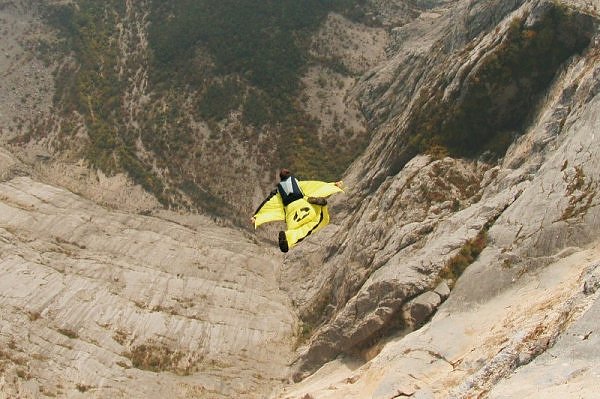If you've ever tried sky-diving (I haven't), or hang-gliding (not me), ballooning, or even high-diving into water, you may understand part of the attraction--as well as the sensible terror--involved in what is called Wingsuit Flying. Wingsuit flying involves jumping from a plane, or from a high cliff, and falling through space using a specially designed webbing (or wing) suit, which enables one to conduct a controlled glide through wide space or very close to the edge of a steep terrain.
I was surprised to learn that people have been trying this out since the early 1930's, with limited success, until this century, when better engineered materials have permitted the invention of more reliable outfits. Everyone has seen film of people sky-diving, facing downward, sometimes in groups, the illusion of floating a visual trick. Parachute jumpers may reach speeds of 100-150 miles per hour in dead-fall, but sky-divers generally go slower through a controlled glide. Sky-diving is dangerous: Uncontrolled "spins" may lead to extreme dizziness, preventing the proper use of the parachute.
But if familiar sky-diving seems absurdly dangerous and foolhardy, consider wingsuit flying. Rather than jumping from a high-flying craft, with miles and miles of open space within which to maneuver and focus on the safe cushion of air, wingsuit jumpers prefer to leap off sheer cliffs, placing themselves directly in the line of descent towards the ground. Thanks to the minor miracle of digital video technology, these jumpers are able to record their flights. Check out the following two videos--the first "Grinding the Crack" and the other "Gliding through the Crack Gorge"
At first, looking at these videos, you lose the sense of orientation, and must remind yourself that the slope of the descent is very much steeper than it can seem, as seen looking straight ahead from the vantage of the jumper. Traveling at speeds of 140 mph this way is a revolutionary step for humankind, albeit limited to a handful of daredevils willing to train and risk the worst. Jumpers wishing to try this maneuver must pass a daunting apprenticeship of hundreds of sky-dives, and then go through a build-up of easier jumps, gradually increasing difficulty. At the top of the sport, a few fearless wing nuts test the outer limits of possibility. Lest you assume that such feats are only accomplished in the outback, check out this scary descent between to twin skyscrapers, and at night!
The ultimate in death-defying risk must be this fellow's desire to aim himself right through a rock window, at speed. This almost stretches credulity. Is this really happening?
This one can literally take your breath away. If it seems visually stunning, imagine what it must feel like physically, the continuous sensation of falling, falling, the intense air pressure, the unrelenting demands of attention, constant adjustment and anticipation in which the loss of focus for even a tiny fraction of a second could mean instantaneous violent death on impact.
What is it that drives individuals to put themselves at this edge of terror? Men have been testing limits for all of recorded history. Is this kind of stuff just dumb joyriding with a deathwish? You might want to turn the sound off, or at least down a bit, as the accompanying music to this last one is a little brutal.
In dreams, we overcome the limits of gravity and fly. But my flying dreams were never like this. In mine, there is no fear, just the ecstatic release, an exalted sense of freedom combined with the drug of a new kind of power over my body. I think we want to know that someone, somewhere is trying things like this, though we may not want to experience the direct rush and mortal risk ourselves. Skateboarders, snowboarders, skiers, surfers, parasailors, stuntmen, race-car drivers. But these aren't things you just do; they require years of training and work, just to get to a level of competence that allows you access to the experience.
Animals don't do this. It's our higher brains that are to blame. In space, weightlessness is the ultimate light-headedness. This is probably what attracts people to computer games.As for me, I was never even able to turn cartwheels. At 6'4", I learned to dunk a basketball--my sole physical feat. In my work, I once met a professional stuntman, who had done all the stunts on the television series Sea Hunt (with Lloyd Bridges); he was a textbook case of all the different kinds of injuries you can suffer by trying the impossible. What are the survival advantages of these kinds of feats?
"Reality is greater than our dreams." --Frederick Sommer.




1 comment:
This certainly puts a new slant on Robert Hayden's Angle of Ascent.
Post a Comment